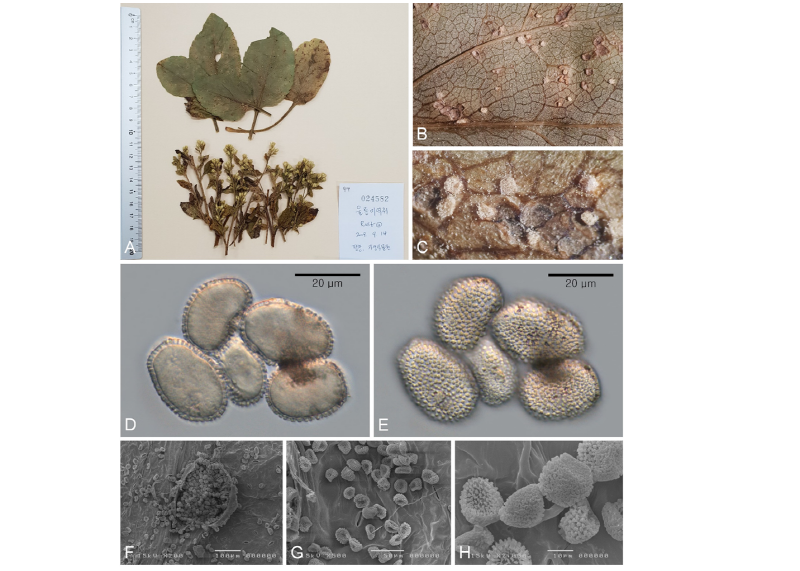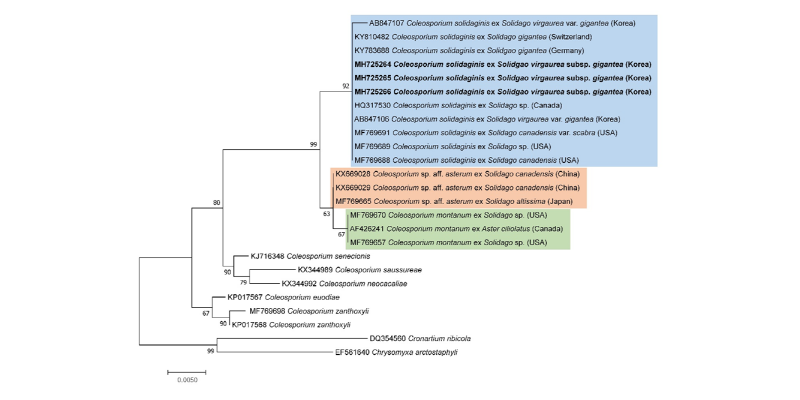울릉미역취[Solidago virgaurea subsp. gigantea (Nakai) Kitam.]는 국화과(Compositae), 참취족(Astereae)에 속하는 다년생 식물로서 우리나라의 특산식물 중 하나이다[1]. 울릉미역취는 울릉도에 자생하는 지리적 아종 또는 변종으로 취급되며[1], 나물로서의 가치가 높아 내륙에서도 널리 재배된다[2]. 우리나라에서 울릉미역취에 발생하는 병해로는 빗자루병[3]과 녹병[4]이 알려졌다. 그 중 녹병은 가식 부위인 잎에 발생하고, 발병 기간도 6월부터 10월까지로 대단히 길어 10%의 수량감소가 추산된다고 했다[4]. 이러한 울릉미역취 녹병의 병원균은 형태적 특징 및 분자분석을 통하여 Coleosporium asterum으로 기록되었다[4]. 하지만 2017년 Beenken 등[5]은 한국에서 기록된 울릉미역취의 녹병균은 28S 염기서열(GenBank AB847106, AB847107)로 해석하면 C. asterum이 아니라 C. solidaginis에 포함시키는 것이 마땅하다고 제시하였다. 이를 근거로 해서 2018년 McTaggart과 Aime [6]도 한국의 울릉미역취 녹병균을 C. solidaginis에 포함시켰다. 따라서 미국농무부의 진균-숙주 분포 데이터베이스[7]에는 C. asterum과 C. solidaginis가 모두 울릉미역취 녹병균으로 등재되어 있다.
이러한 상황은 울릉미역취 녹병을 일으키는 녹병균의 정체성에 혼란을 줄 수 있다. 게다가, 한국에서 분석되어 GenBank에 등재된 울릉미역취 녹병균 시료 2점이 모두 울릉도에서 채집된 것이므로 내륙에서 재배되거나 식재된 울릉미역취의 녹병균에 대한 추가적인 검토가 필요하다고 판단된다. 또한 Back 등[4]이 채집한 시료는 표본보관소에 수장되지 않았으므로 추적이 불가능한 상태이다. 한편, NCBI에 등록된 중국의 Solidago canadensis (= S. altissima, 양미역취) 2점과 일본의 S. altissima(양미역취) 1점의 녹병균은 C. asterum과 C. solidaginis에도 속하지 않는 제3의 그룹으로서 McTaggart과 Aime [6]에 의해 ‘Coleosporium sp. aff. asterum’으로 임시적 이름이 주어진 잠재적 신종이다. 그리고 McTaggart과 Aime [6]은 북미에서 채집된 Solidago spp.의 녹병균은 2 분류군이며, 기존의 C. solidaginis와는 계통학적으로 뚜렷이 구분되는 신종으로 C. montanum을 발표하였다. 따라서 우리나라에 존재하는 울릉미역취 녹병균에 대한 재검토가 필요하다고 판단하였고, 이에 고려대학교 진균표본실에 보존된 울릉미역취 녹병균을 형태적으로 검토하고 분자적으로 분석하여 종 수준으로 동정하여 보고한다.
표본 내역
고려대학교 식물표본보관소(KUS)에 총 3점의 울릉미역취 녹병균이 보존되어 있다. 보존된 시료는 KUS-F23658 (18 Sep 2008, 수원, 농촌진흥청 약용작물전시포장), F24582 (14 Sep 2009, 평창, 한국자생식물원 전시포장), F24664 (24 Sep 2009, 인천, 인천수목원 전시포장) 등 3점이었다.
녹병균의 형태적 특징
보존된 표본시료를 맨눈으로 관찰하여 발병 부위와 표징을 파악하였고, 때로는 해부현미경으로 정확한 관찰을 도왔다. 녹병균의 분류학적 특성을 파악하고 크기를 측정하기 위해서 명시야광학현미경(BX51; Olympus, Tokyo, Japan)을 사용하였다. 광학현미경 사진은 미분간섭현미경(Axio Imager; Carl Zeiss, Oberkochen, Germany)을 이용하여 촬영하였다. 또한, 녹병균의 미세구조를 관찰하기 위해서 주사전자현미경(JSM-5410LV; JEOL, Japan)을 이용하여 사진을 촬영하였다.
여름포자더미(uredinia)는 대부분 잎 뒷면에 형성되었지만 드물게 잎 앞면과 어린 줄기에서도 발견되었으며, 노란색 내지 주황색이었으며, 다소 돌출되었으며, 직경은 대부분 100~300 µm의 범주에 들지만 때로는 2개의 여름포자더미가 붙은 듯이 길게 형성된 경우에는 길이가 600 µm에 이를 정도로 변이의 폭이 컸다. 여름포자(urediniospore)는 매우 짧거나 거의 흔적에 가까운 꼭지(pedicel)가 있으며, 거꾸로계란형 내지 밑이 좁아지는 장타원형이며, 24~32 ⅹ 18~22 µm(자연건조 상태)였다. 여름포자의 세포벽 두께는 약 2 µm이며, 담황색 내지 무색이며, 표면에 미세한 돌기가 분포하였다(Fig. 1). 겨울포자 세대는 채집되지 않았다. 모든 형태적 특징은 Solidago spp.에서 보고된 C. asterum 또는 C. solidaginis의 기재와 일치하였다[8, 9, 10].

Fig. 1. Coleosporium solidaginis associated with Solidago virgaurea subsp. gigantea. A, A herbarium specimen (KUS-F24582) of S. virgaurea subsp. gigantea having rust pustules of C. solidaginis; B, Uredinia formed on the abaxial leaf surface; C, Close-up view of erumpent uredinia; D, E, Urediniospores focused on the median view and the surface view observed under light microscope; F~H, Uredinium (F) and urediniospores (G, H) observed under scanning electron microscope.
염기서열 분석
고려대학교 표본실에 보존되어 있는 울릉미역취 녹병균 시료 3점(KUS-F23658, F24582, F24664)의 시료를 대상으로 28S large subunit (LSU) 영역의 염기서열을 분석하였다. Aime [11]의 방법에 따라 건조 시료에서 채취한 여름포자에서 genomic DNA를 추출하였고, LR0R와 LR6 프라이머를 사용하여 PCR로 증폭시켰다[12]. 증폭된 각각의 PCR 산물을 전기영동을 통하여 확인한 후에 염기서열을 분석하기 위하여 마크로젠(Macrogen, Seoul, Korea)에 의뢰하였다. 분석된 염기서열은 DNASTAR computer package 7.1(Lasergene; DNASTAR, Madison, WI, USA)를 이용하여 정리하였으며, 이들을 NCBI (National Center for Biotechnology Information)의 GenBank에 등록하였다(기탁번호 MH725264, MH725265, MH725266). 이들의 염기서열을 비교한 결과, GenBank에 등록되어 있는 미국의 C. solidaginis (MF769689, MF769688)와 100%의 상동성을 보였다. Solidago-Coleosporium의 분자계통학적인 관계를 명확하게 확인하기 위하여 MEGA7 프로그램[13]을 이용하여 maximum likelihood 방법으로 계통수를 작성하였다(Fig. 2). 그 결과, 한국의 울릉미역취 녹병균 시료 3점은 Back 등[4]이 보고한 C. asterum와 북미 및 유럽의 Solidago spp.에서 채집한 C. solidaginis와 같은 계통으로 묶였으며, 중국과 일본의 Solidago canadensis(= S. altissima, 양미역취)에서 채집한 Coleosporium sp. aff. asterum 및 북미의 Solidago spp.에서 채집한 C. montanum과는 계통학적으로 뚜렷하게 분리되었다.

Fig. 2. Phylogenetic tree based on maximum likelihood analyses of large subunit (LSU) sequences of Coleosporium solidaginis ex Solidago virgaurea subsp. gigantea isolates and some reference isolates retrieved from GenBank. Bootstrap values based on 1,000 replications are indicated above the branches and the scale bar represents 0.005 nucleotide substitutions per site. The Korean isolates presented in this study are indicated in bold.
고찰
미역취속(Solidago)은 국화과의 참취족에 속하며 약 100종을 포함하는 큰 분류군이다[14]. 국내에서는 미역취속에 1종(virgaurea), 2아종(subsp. asiatica, subsp. gigantea), 그리고 2변종(var. coreana, var. leiocarpa)이 분포한다고 알려졌다. 하지만 Jang 등[1]은 산미역취(S. virgaurea var. leiocarpa)가 한국에 분포하지 않는다고 하였다. 최근에 양미역취(S. altissima)와 미국미역취(S. serotina)가 귀화식물로서 널리 분포한다[15]. 따라서 남한에는 자생식물로서 미역취(subsp. asiatica), 울릉미역취(subsp. gigantea), 나래미역취(var. coreana)가 분포하며, 귀화식물로는 미국미역취와 양미역취가 분포하므로 총 5개 분류군이 존재한다.
그 중에서 울릉미역취는 산채자원으로서 나물로 이용되므로 실제 남한의 전 지역에서 재배된다. 앞서 언급한 바와 같이, 울릉미역취 녹병균이 Back 등[4]에 의해 C. asterum으로 보고되었고, 국외의 학자들에 의해 C. solidaginis로 해석되어[5, 6] 혼동을 일으킬 수 있다. 따라서 저자들에 의해 내륙에서 채집된 3점의 울릉미역취 녹병균 시료에 대한 형태적 특징 및 분자적 분석을 통하여 우리나라 울릉미역취 녹병균은 현재의 분류학적 개념에 따른 C. solidaginis로 확인되었다. 이는 일본, 중국, 한국을 포함하는 동아시아 지역에서 C. solidaginis가 공식적으로 확인된 최초의 증거이다. 앞서 일본과 중국에서 양미역취 녹병균이 보고되었으나[6] C. solidaginis와는 계통학적으로 구분되는 분류군이다. 따라서 한국에 분포하는 울릉미역취를 포함한 모든 Solidago spp.의 녹병균에 대한 연구가 뒤따라야 하며, 일본과 중국에서 Solidago spp.를 감염하는 더 많은 시료의 녹병균이 연구되어야 한다. 즉, 동아시아에 분포하는 Solidago spp.의 녹병균에 대한 종합적인 정보가 축적되어야 전세계의 Solidago-Coleosporium 관계를 정확하게 파악할 수 있을 것으로 생각된다.
적요
울릉미역취는 울릉도 원산이지만 한국에서 채소로 널리 재배된다. 울릉미역취의 녹병균은 2014년에 Coleosporium asterum으로 처음 보고되었다. 최근에 북미 시료를 중심으로 미역취속(Solidago)의 녹병균(Coleosporium)을 연구한 논문을 통하여 앞서 한국에서 보고된 울릉미역취 녹병균은 C. solidaginis에 포함시켜야 한다는 의견이 있었다. 이 의견을 확인하기 위하여 고려대학교 표본실에 보존된 울릉미역취 녹병균 시료 3점을 연구하여 C. solidaginis임을 확인하였다. 일본과 중국에서 보고된 양미역취의 녹병균은 C. asterum이나 C. solidaginis과는 구분되는 잠재종으로 추정된다. 본 연구를 통하여 그 동안 북미와 유럽에서만 알려졌던 C. solidaginis가 아시아에도 존재한다는 사실을 처음으로 보고한다.

